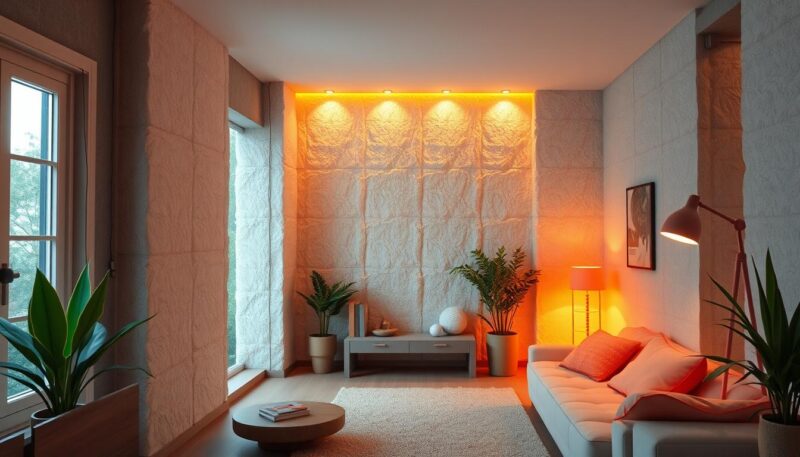The debate about whether to insulate interior walls is ongoing and multifaceted. A common question that arises during home and house renovation projects is: Should You Insulate Interior Walls? To address this, it’s essential to understand both the benefits of insulation and the potential costs involved. From energy savings and improved soundproofing to the environmental impact and the return on investment, numerous factors play into this decision.
Insulating interior walls can significantly impact your home’s energy efficiency and indoor comfort. Adding insulation yields benefits such as reduced heat loss and less reliance on heating systems, which translates to lower energy bills. However, some professionals argue that beyond a certain point, such as achieving R-21 insulation efficiency, the returns start to diminish. This notion hinges on several assumptions, including fluctuating energy costs and expected future savings from the insulation.
If you’re considering whether to insulate, it’s crucial to weigh these factors carefully. In the United States, different climate zones necessitate varying R-values for efficacious insulation, influencing your decision. The cost-effectiveness of higher insulation levels, like moving from R-13 to R-19, needs evaluation based on your unique circumstances. Whether you’re contemplating DIY insulation projects or opting for professional installation, understanding these dynamics is vital for making an informed choice.
Through this analysis, we aim to provide you with comprehensive insights into the benefits of insulation, when to insulate, and the most prudent choices for your home renovation or improvement endeavor. Armed with this knowledge, you will be better equipped to make decisions that enhance both the comfort and value of your home.
Understanding the Benefits of Insulating Interior Walls
Installing insulation in your interior walls offers numerous advantages that enhance your home’s efficiency and comfort. From significant energy savings to soundproofing benefits and reduced environmental impact, understanding the types of insulation and their benefits can guide better choices for your property.
Energy Savings
One of the foremost benefits of insulating interior walls is the profound impact on energy savings. By decreasing heat transfer, interior wall insulation reduces the amount of energy necessary for heating and cooling your home. This not only leads to lower energy bills but also promotes a more sustainable living environment. Various types of insulation, such as injection spray foam or rigid foam board, can enhance these energy savings by regulating temperatures more effectively and boosting HVAC efficiency.
Soundproofing Benefits
Another significant advantage of insulating interior walls is the soundproofing benefits. Insulation materials like mineral wool and fiberglass are excellent for reducing noise transmission between rooms, creating a quieter, more peaceful indoor environment. This is particularly beneficial in multi-story homes or properties near busy roads. The dampening effect provided by these types of insulation helps maintain tranquility and privacy within your living spaces.
Environmental Impact
Proper insulation of interior walls has a positive environmental impact. It minimizes the building’s energy demand, reducing the overall carbon footprint. Additionally, using environmentally friendly types of insulation materials further aligns with green building standards and eco-friendly initiatives. Insulating your interior walls also contributes to moisture control, mitigating the risk of mold growth and improving indoor air quality. By selecting the right types of insulation, such as loose-fill insulation or mineral wool, you can make a substantial difference in promoting environmental stewardship.
Should You Insulate Interior Walls? Weighing the Cost vs. Benefits
When considering whether to insulate interior walls, it’s essential to weigh the costs against the potential benefits. This section delves into a comprehensive cost analysis, evaluates the return on investment, and explores how insulation can impact home comfort and long-term maintenance.
Cost Analysis
The cost of insulating interior walls can vary widely depending on the materials used. Options like fiberglass batts and blown-in cellulose offer cost-effective solutions, while spray foam insulation provides superior air sealing properties but at a higher initial cost. Typically, interior wall insulation costs about half as much as exterior insulation, presenting a more economical choice for homeowners.
| Material | Cost per Square Foot | Benefits | Challenges |
|---|---|---|---|
| Fiberglass Batts | $0.40 – $1.00 | Cost-effective, easy to install | Less effective air sealing |
| Blown-in Cellulose | $0.30 – $1.50 | Good coverage, eco-friendly | Potential settling over time |
| Spray Foam | $1.50 – $3.00 | Excellent air seal, high R-value | High initial cost |
| Mineral Wool | $1.00 – $3.50 | Fire-resistant, noise reduction | Higher cost, labor-intensive installation |
| Rigid Foam Board | $1.80 – $4.50 | High efficiency, moisture control | Expensive, requires wall opening |
Evaluating Return on Investment
Evaluating return on investment involves considering the energy savings over time. Properly insulated interior walls can reduce heat transfer between rooms, allowing HVAC systems to work more efficiently. This improvement can result in substantial energy savings, especially in regions with extreme temperatures, such as Chicago. Furthermore, enhanced indoor temperature regulation through insulation can potentially increase property value, making the initial investment worthwhile.
Home Comfort and Maintenance
Proper insulation significantly enhances home comfort by maintaining consistent indoor temperatures and reducing noise transmission between rooms. This is particularly advantageous in areas with dramatic temperature swings or high noise levels. Additionally, insulation plays a critical role in reducing moisture issues, which can lead to frequent maintenance needs. By insulating interior walls, you can mitigate potential challenges such as air leaks and moisture buildup, ultimately extending the longevity of your property’s structural integrity.
Conclusion
When considering whether to insulate interior walls, it’s essential to evaluate the unique factors influencing your decision. Climate conditions, house design, and financial constraints play crucial roles. While the initial costs for insulation — especially high-grade options like spray foam — can be significant, the long-term benefits such as energy savings, enhanced home comfort, and potential increases in property value justify the investment. Moreover, proper installation adhering to zoning regulations ensures the maximization of these benefits, making professional assistance advisable.
For example, fiberglass insulation offers a lifespan of 80 to 100 years, though exposure to moisture can drastically shorten this. On the other hand, mineral wool, which lasts between 30 and 80 years, provides excellent fire resistance, a crucial consideration for improving home safety. Spray foam presents a durable option but isn’t the most eco-friendly choice. Each insulation type has its pros and cons, adding complexity to your decision-making process.
Ultimately, your final thoughts on insulating interior walls should balance both cost and benefit considerations while closely aligning with your specific needs. An insulated home not only saves on energy expenses but also adds to your comfort, reduces noise transmission, and meets fire safety regulations. By consulting professional contractors, you can ensure the optimal selection and installation of insulation, tailored to your zoning regulations and unique circumstances. This holistic approach promises not just one aspect of improvement but a comprehensive enhancement of your living environment.


